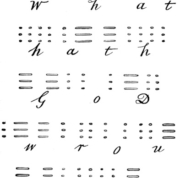On this day in 1814, United States soldiers raised this 30′ x 42′ foot garrison flag over Fort McHenry in Baltimore to celebrate a critical victory over the British during the War of 1812:

Seeing those “broad stripes and bright stars” inspired Francis Scott Key to write a poem entitled “Defence of Fort M’Henry.” It soon became the song we know as “The Star-Spangled Banner,” and eventually, Our national anthem.
In turn, that flag, and the following words from the fourth stanza of Key’s poem inspired Our Lost Founding to create this t-shirt design:
“Then conquer we must, when our cause it is just,
And this be our motto – “In God is our trust,”



